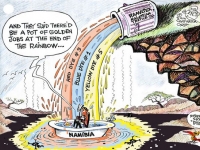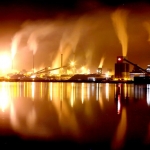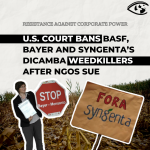Regulating Ramatex: Authorities Shut Out as Malaysian Investor Threatens Namibian Environment

For nearly six years Ramatex Textile and Garment Factory barred government regulators from entering prime industrial premises the company leased from the City of Windhoek. Meanwhile, the Malaysian textile giant was polluting the area around its Namibian factory with salty wastewater. Evidence of the violations finally emerged after the company absconded and the city commissioned an environmental audit.
Sam Hugo is 53 years old and self-employed. He lives at House Number 4, Amsterdam Street, about 50 meters from the now defunct Ramatex factory. Sam has lived at this house with his wife Francina, 51, son Nolan, 30, and daughter Samantha, 23, for 14 years. His grandchildren - many younger than 10 years old - live with him. He says fumes blow from Ramatex toward his house.
"Before Ramatex came here we were all healthy. My wife started experiencing difficulties in breathing when Ramatex began operations. She is still sick but her condition improved after they left. My son Nolan developed sinus at about the same time that my wife fell sick, and my daughter and I have completely lost the sense of smell. I suspect it is because of the fumes we inhaled," he told CorpWatch at his house as members of his family nodded in agreement. Sam cannot afford to take his family to doctors, but his family is one of scores whose conditions doctors say could be linked to pollution.
Ramatex Textile and Garment Factory came to Namibia in 2001, lured by the newly implemented African Growth and Opportunity Act (AGOA). The U.S. trade agreement allowed businesses in sub-Saharan Africa to export garments tariff free into the United States. President George Bush signed the 2001 agreement to "tap the power of markets to improve the lives of [U.S. and African] citizens."
Ramatex had manufacturing operations in several Asian countries, as well as in Mauritius and South Africa and at the turn of the 21st century, Namibia was eager for investment and jobs. With fewer than 300,000 people, Windhoek is Namibia's capital and largest city. It sits in the semi-arid middle of the southern African nation, which won independence from South African administration in 1990.
Ramatex promised the Namibian government the biggest garment factory in southern Africa and projected a workforce of up to 15,000 people.
Facing an unemployment rate of 20 to 30 percent, Namibia's political leadership wasted no time in rolling out the red carpet. On June 14, 2001, Ramatex opened in Otjomuise, a suburb on the outskirts of Windhoek.
Windhoek spent more than US$60,000 in developing the industrial site before Ramatex moved in. The government provided the 60-hectare location with electricity and sewerage infrastructure to the tune of almost $US13 million, and granted a 99-year lease exemption.
The government also extended lucrative manufacturing incentives to the Malaysian company under the Export Processing Zone scheme through exemption of corporate taxes and of wharfage charges.
In no time Ramatex, which invested an estimated US$100 million plus in the new factory, metamorphosed into an untouchable political project.
In the rush to development, the plant's potential environmental impact was given less than rigorous oversight. Best practice all over the world requires that before an investor is allowed to operate, an Environmental Impact Assessment (EIA) "must produce a baseline upon which the business runs," said Dr. David Phillips of the Windhoek-based independent auditing firm of Phillips Robinson and Associates. "It is the most important tool for protecting the environment, especially in developing countries."
Phillips charged that another Malaysian company Ramatex chose to conduct the EIA, "does not look like it was an experienced company. That EIA wasn't done in keeping with international best practice and was never finalized to the satisfaction of the City of Windhoek," Phillips said.
Piet du Pisani, the City of Windhoek's strategic executive for Infrastructure, Water and Waste Management, confirmed to CorpWatch that Ramatex presented an "unsatisfactory" EIA, which was rejected with suggestions for improvement.
"We never got the final draft," du Pisani said.
Water Pollution, Health Impacts
"What kinds of dyes and other chemicals were they using?" Phillips said in an interview with CorpWatch. City officials "were not certain of exactly what Ramatex was doing behind closed doors," he said. "There are lots of dyes one can use in this industry and they are all different in terms of their environmental impact. Some are cumulative and toxic to the environment. If Ramatex had been using dangerous chemicals which contain [heavy metals such as] mercury or cadmium, or light organic compounds, and decided to irrigate the site, these chemicals would have built up and accumulated in soils and stream beds."
In fact, Phillips' audit found that things could have been far worse. "We are lucky, because inspectors had no access to the site and only had Ramatex's word that they were behaving themselves," he said.
While Ramatex guards kept regulators at bay, the plant pumped its unmonitored waste into the environment. It dumped highly salty wastewater into a public sewer, and irrigated the premises and surrounding areas with the wastewater containing high concentrations of dye and salt. Although the plant had treatment lagoons, they soon filled up, and Ramatex released the waste in violation of its lease.
The treatment plant connected with the dye house also proved inadequate. "Therefore, they could not recycle the effluents and re-use them as the city wanted them to do, and [Ramatex] began to dispose of the effluents in all sorts of ways they were not supposed to," Philips said.
"There were some people who had specific complaints during the time that they stayed in the area surrounding Ramatex," said Dr. Guise Laurie, a medical doctor who, at Phillips' behest, conducted a survey on the effects of Ramatex's operation on locals' health. "There are people who had medical problems such as sinus and dermatological infections which stopped when Ramatex closed, but a correlation can only be confirmed by further studies. I have no doubt that there are some people who were affected, but that has to be proven," the doctor said.
Today, the water in the ponds on the Ramatex site is heavily polluted with salt used as a dye fixative, and there are several large containers of hydrocarbons that need to be disposed of. City officials estimate dealing with Ramatex's messy leftovers - which include 120,000 cubic meters of salty wastewater and sludge on the site - will cost about US$200,000.
Phillips is concerned that even though Ramatex is responsible for salinating surface and groundwater, it will not be held responsible. City of Windhoek monitoring has established "no direct link between Ramatex polluting the ground waters and someone getting sick because they are drinking it. And that creates a difference in the kind of liability they have."
A Company Absconds
The whole question of holding Ramatex responsible may be moot. In early 2008 the company abruptly pulled up stakes and left Namibia. Its departure came in the midst of controversy around charges of pollution and bad labor practices - including forced pregnancy tests for female job applicants, and insufficient health and safety measures, according to Trade Union Solidarity Center of Finland (TUSCF), which monitors business and human rights practices.
It was only after the damage was done that the city commissioned Phillips to lead the environmental audit.
By then, Ramatex had quietly spirited away factory equipment to unknown countries, according to reports at the City of Windhoek. It was an inglorious exit for an investor that had arrived amid pomp and fanfare, supported by millions in international and local largess. At the height of its Namibian operations in 2004, Ramatex and its subsidiaries employed 7,000 workers, including more than 1,000 Asian migrant workers that it brought in and paid better than the local labor. That year, the company was "exceeding our projected turnover of US$300 million," and employing more than 25,000 people worldwide, according to its corporate website.
When Ramatex left, some Namibians had nothing to show but scars from injuries sustained while in its employ, according to Dr. Ben Mulongeni, a senior manager with Khomas Regional Council, under which Otjomuise falls.
"I was never in support of Ramatex. How did we benefit from its being here?" he asked at a recent public meeting at which the results of the environmental audit were discussed.
Certainly not in sustained economic development. The Namibian company is now under liquidation and officials are busy auctioning what little equipment remains at the site.
Acting in Bad Faith?
"The company managed to mislead Namibia (in particular the government) time and again by providing false information to hide its true intentions of using the country merely as a temporary production location," charged TUSCF.
When Ramatex was being set up, the company had negotiated with the city council over water use and management of wastewater, du Pisani said, and local and central government officials traveled twice to Malaysia. The visits resulted in conflicting information over the company's plans for treating and disposing of wastewater contaminated by garment dyeing.
In fact, Phillips told CorpWatch that Ramatex "never commissioned high quality wastewater treatment facilities, although they brought some equipment which was never removed from its boxes. They then tried all sorts of things which were not allowed in their lease agreement, to get rid of the wastewater."
The lack of safeguards and inadequate pre-construction EIA were early pieces in a pattern of poor oversight and accountability. "It shows that the regulatory authorities and the industries are working off different pages because there are things that are not clear," said Phillips. "In this instance, things were made worse by the fact that Ramatex did not cooperate with the City of Windhoek, whose officials had no access to the site despite guarantees in the lease agreement. Each time regulators tried to enter the 60-hectare premises, guards posted at the gates would bar them," Phillips said, adding that this should never have been allowed.
"My experience everywhere in the world is that you do your best in terms of the legislation to ensure that the regulatory authority has a right to enter the premises anytime they please. I have been in situations where the regulator has to call in advance saying they intend to visit and people do all sorts of things to hide all the bad things they have been doing," he said.
Du Pisani said that he and other city officials only countenanced an investor barring them from what was essentially the city's property, because their hands were tied.
"This project had such a high political profile on account of the number of jobs that it said it would create, that it was difficult for us to enforce anything," said the executive for Infrastructure, Water and Waste Management.
When political desires overshadow environmental concerns, the result is often "a mess," said Phillips. "My view is that industrial tenants who come with the sort of attitude Ramatex had, should go away."
A Country Left Behind
That, of course, is what Ramatex did, but without cleaning its mess. Fortunately for the present generation of Windhoek residents, the polluted aquifer flows away from the city and is not contaminating drinking water the city draws from underground sources.
Namibia's ombudsman, Advocate John Walters, said that the city ignored warnings that all was not well. When he took office in 2004 (when President Hifikepunye Pohamba's government took over from that of founding President Sam Nujoma), he found a big file of correspondence from Earth Life Africa Namibia, an environmental watchdog group. The letters from ordinary skeptical residents called for an investigation into what was going on at Ramatex.
"Last year, they asked me to respond to their complaints, which I could not do. I commend the city of Windhoek for undertaking this audit. We have learnt lessons," he said, referring to the Phillips Robinson and Associates investigation.
Walters assured Earth Life Africa Namibia, other environmental activists, and Namibia citizens that there would not be a repeat of the recklessness that characterized Ramatex's operation.
"We will never sit and close our eyes and not be allowed to investigate complaints of this nature, which could have had worse effects," he said.
Phillips said given Ramatex's belligerence, it was "deeply fortunate" that it did not pollute the environment more seriously than it did. And while the company handled wastewater badly, its solid waste management was good, he said.
In future, "it is important that we do the initial studies well and be sure that we have a very robust EIA system, not just in the law but in practice - and where there are different authorities involved, they should all be listened to, so that everybody is on the same page. We should think of what kinds of industries we would want in a place like Namibia. I would not recommend for the authorities to involve more 'thirsty' industries in Namibia because water resources are already under pressure and domestic use of water is always considered first in other countries."
Industries vary in how much water they use per dollar made. Textile industries like Ramatex use lots of water, while profitable electronics industries do not.
Du Pisani said city authorities finally got access to the site in 2007 around the time Ramatex had decided to vacate the premises. According to Du Pisani, Ramatex officials were uncooperative with Phillips' environmental investigation, and not even the auditor could reach them. Neither did Ramatex officials respond to an email from CorpWatch requesting for an interview for this article.
For Du Pisani, the only benefit from Ramatex coming into the country was that about 4,000 people were employed, "albeit at very low wages."
"If Ramatex had been run properly, it would have benefited the country as a whole," he said.
- 104 Globalization
- 106 Money & Politics
- 110 Trade Justice
- 184 Labor
- 190 Natural Resources
- 208 Regulation



